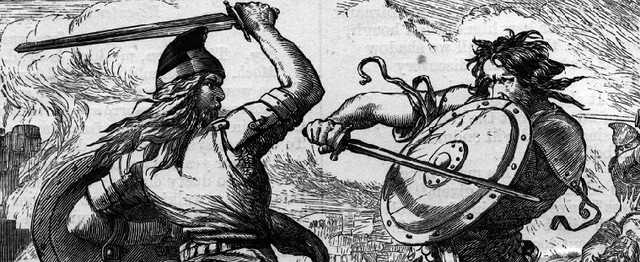

Malcolm, Macduff, and the English forces march on Macbeth, and Macduff kills him. Meanwhile, Macbeth murders Macduff's family. Macduff leaves Scotland for England to prod Duncan's son, Malcolm III of Scotland, into taking the Scottish throne by force. When Macbeth calls upon his nobles to contribute to the construction of Dunsinane castle, Macduff avoids the summons, arousing Macbeth's suspicions. Macduff first appears in Holinshed's narrative of King Duncan after Macbeth has killed the latter and reigned as King of Scotland for 10 years. In Holinshed's narrative, attributes of King Duff are transposed onto the MacDuff mormaer from Macbeth's era. This association not only secured the Duff family influence in the peerage, but also helped ensure their position as one of the largest landowners in Scotland, heading countless feudal baronies including the barony of MacDuff, named for James Duff, 2nd Earl Fife. Various Fife titles were held by the Duffs until as recently as 1929 when the dignity passed to the Carnegie descendants, where it remains in use today. In 1759, his descendent William Duff was granted the historic Celtic Title of “Fife”, resurrecting the title and tying the Duffs of Northeast Scotland, both to the their 11th century Lowland ancestors, and to Shakespeare’s MacDuff.

In 1404 David Duff received a charter in Aberdeenshire from Robert III of Scotland. Few could determine where Duff Family history began and historical fiction ended, working to the benefit of the Duffs as their reach expanded into Northeast Scotland.

Not only did history influence Shakespeare’s work, but the work itself influenced the role of future Duffs. The ruins of Macduff's Castle lie in the village of East Wemyss next to the cemetery. Their clan – the Clan MacDuff – remained the most powerful family in Fife in the Middle Ages. Due to the Irish use of tanistry, Duff's immediate descendants did not become rulers of Alba, and instead became mormaers of Fife. The Orygynale Cronykil suggests that Duff was murdered. In John of Fordun's work, the reign of Duff is portrayed as having suffered from pervasive witchcraft. Historically, Duff was a 10th century King of Alba. These served as the basis for the account given in Holinshed's Chronicles (1587), on whose narratives of King Duff and King Duncan Shakespeare in part based Macbeth. The overall plot that would serve as the basis for Macbeth is first seen in the writings of two chroniclers of Scottish history, John of Fordun, whose prose Chronica Gentis Scotorum was begun about 1363, and Andrew of Wyntoun's Scots verse Orygynale Cronykil of Scotland, written no earlier than 1420. Shakespeare drew mostly from Holinshed's Chronicles (1587).Īlthough characterised sporadically throughout the play, Macduff serves as a foil to Macbeth and a figure of morality. The character is first known from Chronica Gentis Scotorum (late 14th century) and Orygynale Cronykil of Scotland (early 15th century).

He can be seen as the avenging hero who helps save Scotland from Macbeth's tyranny in the play. Macduff, a legendary hero, plays a pivotal role in the play: he suspects Macbeth of regicide and eventually kills Macbeth in the final act. Lord Macduff, the Thane of Fife, is a character and the main antagonist in William Shakespeare's Macbeth (c.1603–1607) that is loosely based on history. John Langford Pritchard as Macduff, depicted by Richard James Lane in 1838


 0 kommentar(er)
0 kommentar(er)
